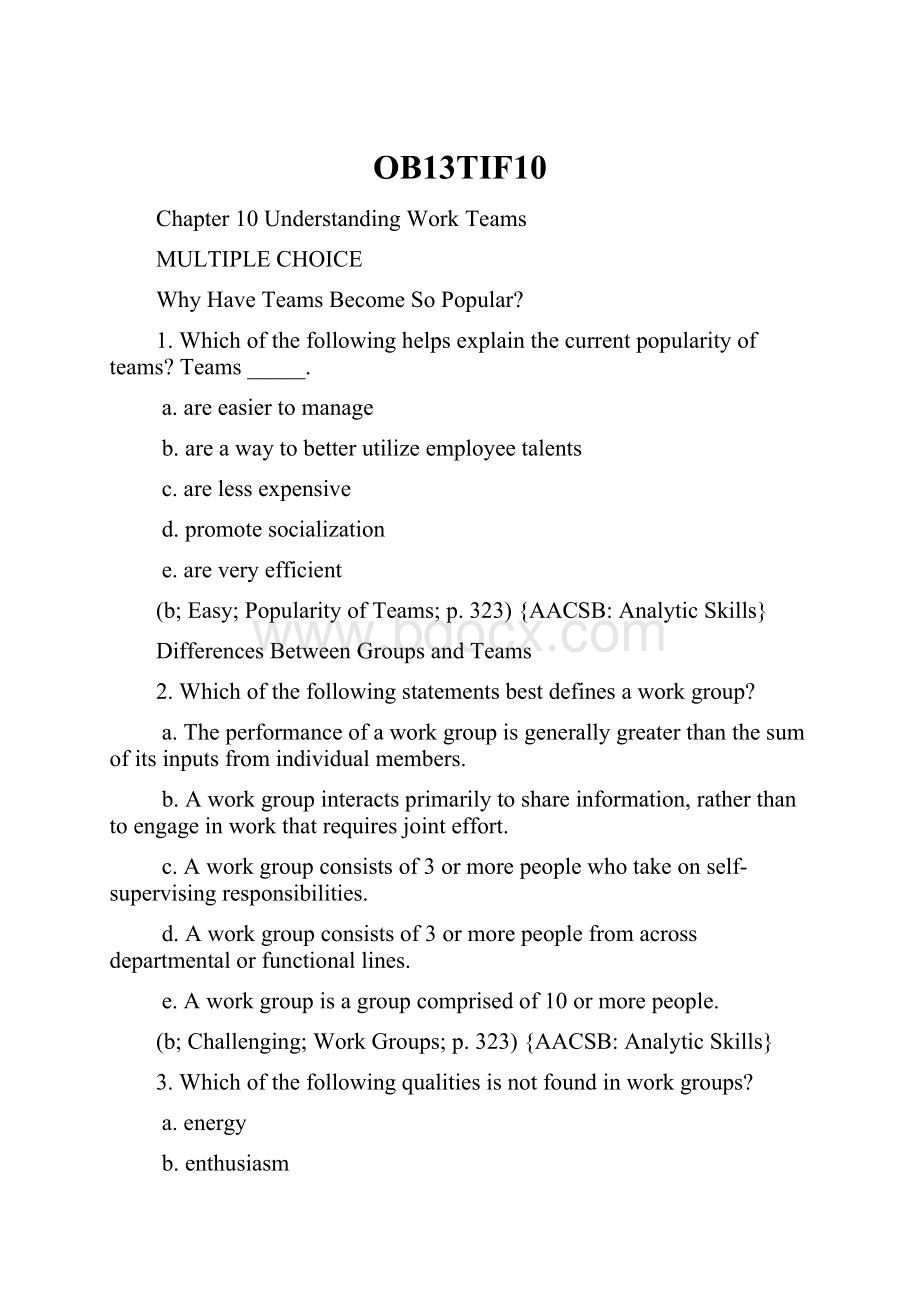OB13TIF10.docx
《OB13TIF10.docx》由会员分享,可在线阅读,更多相关《OB13TIF10.docx(33页珍藏版)》请在冰豆网上搜索。

OB13TIF10
Chapter10UnderstandingWorkTeams
MULTIPLECHOICE
WhyHaveTeamsBecomeSoPopular?
1.Whichofthefollowinghelpsexplainthecurrentpopularityofteams?
Teams_____.
a.areeasiertomanage
b.areawaytobetterutilizeemployeetalents
c.arelessexpensive
d.promotesocialization
e.areveryefficient
(b;Easy;PopularityofTeams;p.323){AACSB:
AnalyticSkills}
DifferencesBetweenGroupsandTeams
2.Whichofthefollowingstatementsbestdefinesaworkgroup?
a.Theperformanceofaworkgroupisgenerallygreaterthanthesumofitsinputsfromindividualmembers.
b.Aworkgroupinteractsprimarilytoshareinformation,ratherthantoengageinworkthatrequiresjointeffort.
c.Aworkgroupconsistsof3ormorepeoplewhotakeonself-supervisingresponsibilities.
d.Aworkgroupconsistsof3ormorepeoplefromacrossdepartmentalorfunctionallines.
e.Aworkgroupisagroupcomprisedof10ormorepeople.
(b;Challenging;WorkGroups;p.323){AACSB:
AnalyticSkills}
3.Whichofthefollowingqualitiesisnotfoundinworkgroups?
a.energy
b.enthusiasm
c.synergy
d.objectives
e.security
(c;Moderate;WorkGroups;p.323){AACSB:
AnalyticSkills}
4._____resultsinalevelofperformancethatisgreaterthanthesumoftheindividualinputs.
a.Synergy
b.Enthusiasm
c.Energy
d.Initiative
e.Inversion
(a;Moderate;Synergy;p.323)
TypesofTeams
5.Whichisnotoneofthemostcommontypesofteams?
a.problem-solving
b.interdepartmental
c.self-managed
d.virtual
e.cross-functional
(b;Easy;TypesofTeams;p.324){AACSB:
AnalyticSkills}
6.Whichtypeofteammeetstodiscusswaystoimprovequality,efficiency,andtheworkenvironment?
a.self-managed
b.virtual
c.problem-solving
d.cross-functional
e.committee
(c;Easy;Problem-SolvingTeams;p.324){AACSB:
AnalyticSkills}
7.Whichofthefollowingtypesofteamswouldmostlikelybeassembledtoimprovetheefficiencyofacompany’sproductionprocess?
a.cross-functional
b.problem-solving
c.self-managed
d.virtual
e.co-evolving
(b;Difficult;Problem-SolvingTeams;p.324){AACSB:
AnalyticSkills}
8.Whichofthefollowingtypesofteamswouldmostlikelyempoweritsteammemberstomakework-relateddecisions?
a.technical
b.self-managed
c.problem-solving
d.management
e.reactive
(b;Moderate;Self-ManagedTeams;p.325){AACSB:
AnalyticSkills}
9.Self-managedteamsaretypicallycomprisedofhowmanymembers?
a.2-5
b.5-10
c.8-12
d.10-15
e.over100
(d;Moderate;Self-ManagedTeams;p.325)
10._____teamsaremadeupofemployeesfromaboutthesamehierarchicallevel.
a.Problem-solving
b.Self-managed
c.Cross-functional
d.Multifaceted
e.Starmatrix
(c;Easy;Cross-FunctionalTeams;p.326){AACSB:
AnalyticSkills}
11._____teamsareaneffectivewaytoallowpeoplefromdiverseareaswithinanorganizationtoexchangeinformation,developnewideasandsolveproblems,andcoordinatecomplexprojects.
a.Self-managed
b.Problem-solving
c.Cross-functional
d.Multifaceted
e.Starmatrix
(c;Moderate;Cross-FunctionalTeams;p.326){AACSB:
AnalyticSkills}
12.Theearlystagesofdevelopmentofacross-functionalteamaretime-consumingbecause_____.
a.mostcross-functionalteammembersarecomprisedofindividualsfromsimilarbackgrounds
b.membersmustresearchthecausesofproblemswhichtheyareassignedtosolve
c.mostcross-functionalteammembershavealreadyestablishedtrust
d.membershavetolearnhowtoperformnewfunctionaltasks
e.membersmustlearntoworkwithdiversityandcomplexity
(e;Challenging;Cross-FunctionalTeams;p.326){AACSB:
AnalyticSkills}
13.Whichofthefollowingtypesofteamsallowsforcollaborationbetweenteammemberswhoarephysicallydispersed?
a.local
b.interactive
c.real-time
d.virtual
e.global
(d;Easy;VirtualTeams;p.326){AACSB:
AnalyticSkills}
14.Whichofthefollowingisnottrueaboutvirtualteams?
a.Thereisanabsenceofparaverbalcues.
b.Membersaremoresatisfiedwiththegroupinteractionprocess.
c.Thereislimitedsocialcontext.
d.Theyaremoretask-oriented.
e.Membersaremorefocusedonproductionthanonprocess.
(b;Moderate;VirtualTeams;p.326){AACSB:
AnalyticSkills}
CreatingEffectiveTeams
15.Whichofthefollowingstatementsbestcharacterizestheuseofworkteams?
a.Teamsareunnecessaryifanindividualcandothejobbetter.
b.Teamsarenecessaryforencouragingindividualstoworkindependently.
c.Withinacompany,teamsperformbestiftheyarestructuredsimilarly.
d.Employeesareusuallyresponsibleforsuggestingthatteamsbecreated.
e.Insuccessfulcompanies,teamworkisalwayspreferabletoindividualwork.
(a;Moderate;UseofWorkTeams;p.327){AACSB:
AnalyticSkills}
16.Whichofthefollowingisnotoneofthekeycomponentsofeffectiveteams?
a.effectiveworkdesign
b.recognizedcompanyidentity
c.supportivecontextualinfluences
d.well-managedteamprocesses
e.appropriateteammembership
(b;Moderate;ComponentsofEffectiveTeams;p.327){AACSB:
AnalyticSkills}
17.Therearefourcontextualfactorsthatappeartobemostsignificantlyrelatedtoteamperformance.Whichofthefollowingisnotoneofthosefactors?
a.adequateresources
b.workautonomy
c.effectiveleadership
d.aperformanceevaluationandrewardsystemthatreflectsteamcontributions
e.Alloftheabovearecontextualfactors.
(b;Moderate;ContextualFactorsofEffectiveTeams;pp.328-329){AACSB:
AnalyticSkills}
18.Toprovideteamswithadequateresources,acompanymustsupplywhichofthefollowing?
a.properequipment
b.adequatestaffing
c.encouragement
d.alltheabove
e.noneoftheabove
(d;Moderate;AdequateResources;p.328){AACSB:
AnalyticSkills}
19.Tosucceedinachievingtheirgoals,teamsmust_____.
a.havestrongleadership
b.haveautonomy
c.receivesupportfrommanagement
d.alloftheabove
e.noneoftheabove
(c;Moderate;AdequateResources;p.328)
20.Ina________teamthemanager’sjobbecomesmanagingoutsidetheteam.
a.technical
b.self-managed
c.problem-solving
d.management
e.reactive
(b;Moderate;LeadershipandStructure;p.329)
21.Leadershipisespeciallyimportantin________--wheredifferentteamsneedtocoordinatetheireffortstoproduceadesiredoutcome.
a.technicalteams
b.self-managedteams
c.problem-solvingteams
d.managementteams
e.multi-teamsystems
(e;Moderate;LeadershipandStructure;p.329)
22.Whichofthefollowingstatementsbestservestoweakentheargumentthattrustcontributestoteameffectiveness?
a.Themostcooperativeteamsarethosethatsharethegreatestamountoftrust.
b.Teammemberswhotrusteachothertendtospendlesstimemonitoringeachother’sbehavior.
c.Regardlessoftrustlevel,mostindividualsresistexposingvulnerabilitiestotheirco-workers.
d.Researchshowsthattrustamongteammembersisdirectlylinkedtomembers’willingnesstotakerisks.
e.Teamswiththehighesttrustratingsfortheirleadershiptendtooutperformteamswithlowerleadershiptrustratings.
(b;Challenging;Trust;p.329){AACSB:
AnalyticSkills}
23.Inadditiontoevaluatingandrewardingemployeesfortheirindividualcontributions,managementshouldconsiderusingwhichofthefollowingtoreinforceteameffortandcommitment?
a.personalizedincentives
b.consistentwagesforallteammembers
c.individualperformanceevaluations
d.fixedhourlywages
e.profitsharing
(e;Moderate;RewardSystems;p.329)
24.Effectiveteamsrequirewhichofthefollowingskills?
a.problem-solvingskills
b.technicalexpertise
c.interpersonalskills
d.alloftheabove
e.noneoftheabove
(d;Moderate;SkillsofTeamMembers;p.330){AACSB:
AnalyticSkills}
25.Teammemberswithgoodlistening,feedback,andconflictresolutionskillspossess_____.
a.technicalexpertise
b.problem-solvingskills
c.decision-makingskills
d.interpersonalskills
e.cognitiveappraisalskills
(d;Easy;SkillsofTeamMembers;p.330){AACSB:
Communication}
26.Arecentreviewoftheliteraturesuggestedthat________oftheBigFivetraitswas/wereespeciallyimportantforteamperformance.
a.1
b.2
c.3
d.4
e.5
(c;Easy;Personality;p.331)
27.Whattypesofpeoplearevaluableinteamsbecausethey’regoodatbackingupfellowteammembersandatsensingwhenthatsupportistrulyneeded?
a.conscientiouspeople
b.extrovertedpeople
c.introvertedpeople
d.agreeablepeople
e.openpeople
(a;Easy;Personality;p.331)
28.Evidencetendstosuggestthatperformanceacrossteamswillbehigherifanorganization________.
a.formsonlyteamshighinconscientiousness
b.formsonlyteamslowinconscientiousness
c.formsbothteamshighinconscientiousandteamslowinconscientiousness
d.seedseachteamwithafewpeoplewhoscorehighonconscientiousness
e.seedseachteamwithafewpeoplewhoscorelowonconscientiousness
(c;Moderate;Personality;p.331){AACSB:
AnalyticSkills}
29.Onestreamofresearchhasidentifiedpotentialteamrolesthatpeopleprefertoplay.The“creator”roleisonewho_____.
a.championsideas
b.initiatesnewideas
c.providesstructure
d.coordinatesandintegrates
e.managessubordinates
(b;Challenging;KeyRolesofTeams;p.332){AACSB:
AnalyticSkills}
30.Oftheninekeyrolesonteams,the“promoter”isthegroupmembermostlikelyto_____.
a.developoriginalideas
b.defendandsupportnewly-developedideas
c.providestructurefortheteam
d.fightbattleswiththoseoutsideoftheteam
e.conflictwithotherteammembers
(b;Moderate;KeyRolesofTeams;p.